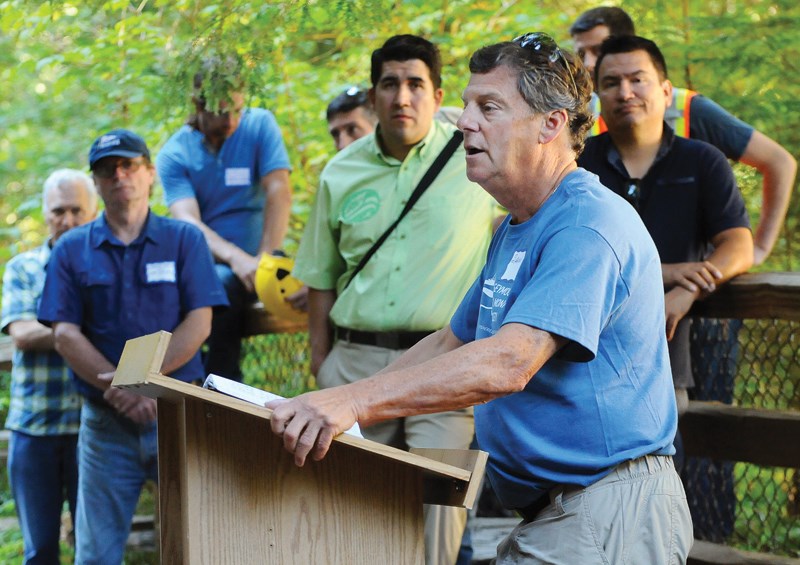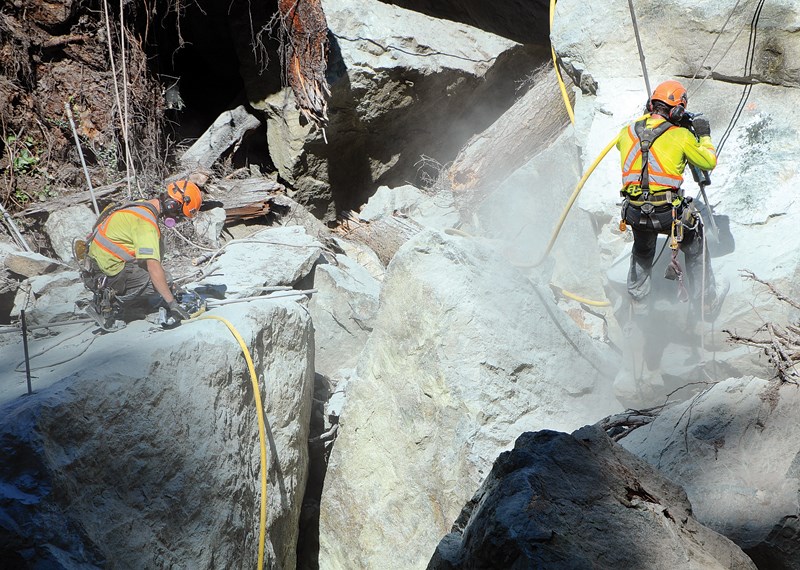The Seymour Salmonid Society is moving mountains to save the Seymour River as a habitat for salmon and steelhead – or at least breaking boulders.
Work kicked off this week for the mitigation project to slowly blast away some of the 50,000 cubic metres of granite that slid into the Seymour in December 2014, making its impassible for spawning fish.
Behind the gathered dignitaries at a ceremony on the Fisherman’s Trail Wednesday, professional rock climbers were scaling the cliff face above the slide, knocking loose any smaller rocks and boulders. At the toe of the slide, they are using pneumatic drills to drill holes two metres deep into the massive boulders. Using a low-velocity explosive called NX Burst, crews will break apart the rock, leaving them to the mercy of winter storms and spring runoff.

“It’s all about making the river passable by fish again. It’s a two- to five-year project. It’s going to take some time but we believe, thanks to the partners we have with us today, that it is doable,” said Shaun Hollingsworth, salmonid society president. “Some of the rocks down here below us are the size of your house. We’re going to make them smaller. We’re going to let Mother Nature, with those… water flows, move the rocks downstream to the deep pools that are situated in the canyon.”
According to one Fisheries and Oceans Canada member, the Seymour is the destination for 30 to 50 per cent of the coho salmon that come to Burrard Inlet. In the meantime, volunteers with the society have been physically catching returning salmon and steelhead at a specially made fish fence lower on the Seymour and trucking them up above the slide site.
Joining in the mitigation project is Tsleil-Waututh and Squamish nations, the federal Department of Fisheries and Oceans, the B.C. Ministry of Forests, Lands and Natural Resource Operations, Metro Vancouver and the District of North Vancouver.
The federal government has put up $600,000 over three years for the project, which could have a total bill of $1.25 million if it runs for five years. The province has contributed $50,000 and the salmonid society has received grants from the Pacific Salmon Foundation, the Habitat Conservation Trust Foundation, Freshwater Fisheries Society, City and District of North Vancouver, Coho Society of the North Shore, Steelhead Society of B.C., B.C. Federation of Drift Fishers, and multiple private donations.
The Squamish and Tsleil-Waututh nations lent a spiritual dimension to Wednesday’s ceremony with prayer songs.
“In our teachings, everything in the forest – everything on Mother Earth – has a spirit, including the rock,” said Chris Lewis, elected council member with the Squamish Nation. “We’re going to pay homage to the spirit of the rock, let the rock know what is happening with the blasting – that is going to be a disturbance.”
And Lewis noted, the salmon have a storied place in Squamish lore, regarded as a force to bring people together, much like the rock slide mitigation project had.
“The salmon are a people to us. They come from a great land out in the ocean. There are stories that go back to the origins that remind us of our connection to the salmon people. Those stories that the salmon have, have the power to bring us all together and they have the power to divide us, so it’s a delicate balance and I’m very proud to be here,” he said. “If the spirit of the rocks did not fall into the river, would we all be here today? Would we all be working together? Or would we all be in our own separate offices doing what we always do, and not talking to one another?”



